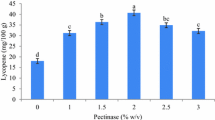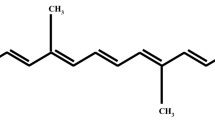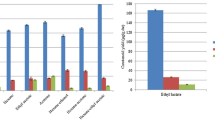Abstract
Cis-isomers of lycopene has been demonstrated to possess higher biological activity than its all-trans form. The objectives of this study were to compare the extraction efficiency and degree of isomerization of lycopene by employing supercritical carbon dioxide (SCD) and solvents, as well as process the lycopene extract into powder containing high proportion of cis-isomers from tomato pulp as source. Results showed that a high yield of lycopene was achieved by SCD at 350 bar and 70 °C, with cis-isomers making up 41.4% of total lycopene. However, with temperature at 80 and 90 °C, the maximum isomerization was accomplished, and cis-lycopene constituted 51.0 and 53.8% of total lycopene, respectively. For solvent extraction, the highest yield of all-trans-lycopene was attained by ethanol–hexane (4/3 v/v) at 25 and 50 °C, whereas the maximum isomerization (47.0% cis-lycopene) occurred at 75 °C. A powder product containing 34.5% cis-isomers of lycopene was obtained by spray-drying, and the total amount of lycopene in spray-dried powder was much greater than that in freeze-dried powder. The maximum yield of lycopene in the powder product could be obtained through processing by adding sodium alginate to the eluate directly after SCD extraction and open-column chromatography with formation of 41.4% cis-lycopene. The method developed in this study may be used for possible commercial production of highly active lycopene powder.






Similar content being viewed by others
References
Shi J, Le Maguer M (2000) Crit Rev Food Sci Nutr 40:1–42
Lin CH, Chen BH (2003) J Chromatogr A 1012:103–109
Boileau AC, Merchen NR, Wasson K, Atkinson CA, Erdman JW Jr, (1999) J Nutr 129:1176–1181
Sadler G, Davis J, Dezman D (1990) J Food Sci 55:1460–1461
Baysal T, Ersus S, Starmans DAJ (2000) Food Chem 48:5507–5511
Rozzi NL, Singh RK, Vierling RA, Watkins BA (2002) J Agric Food Chem 50: 2638–2643
Cadoni E, Giorgi MRD, Medda E, Poma G (2000) Dyes Pigments 44:27
SAS (2003) SAS Procedures and SAS/Graph User's Guide, Version 6. SAS Institute, Cary, NC, USA
Chen BH, Tan YC (1998) J Agric Food Chem 46:2313–2318
Lee MT, Chen BH (2002) Food Chem 78:425–432
Author information
Authors and Affiliations
Corresponding author
Rights and permissions
About this article
Cite this article
Wang, C.Y., Chen, B.H. Tomato pulp as source for the production of lycopene powder containing high proportion of cis-isomers. Eur Food Res Technol 222, 347–353 (2006). https://doi.org/10.1007/s00217-005-0058-2
Received:
Revised:
Published:
Issue Date:
DOI: https://doi.org/10.1007/s00217-005-0058-2




